Operation Eagle Claw
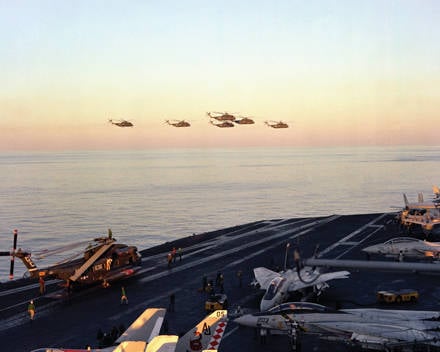 Since the end of the Eagle Claw operation, 33 has passed the year, but, alas, so far much is unclear in this confusing stories.
Since the end of the Eagle Claw operation, 33 has passed the year, but, alas, so far much is unclear in this confusing stories.The drama in Tehran began on November 4. 1979. A crowd of 400 people stating that they are members of the Organization of Muslim Students - followers of Imam Khomeini’s course, attacked the US diplomatic representation. The embassy staff appealed to the Iranian police for help, which, by the way, did not deploy its usual guard squad at the embassy that day. However, these requests remained unanswered. After a couple of hours, the attackers managed to crush the 13 of American marines who threw tear gas into the crowd. The embassy was captured, and the organizers of the attack publicly stated that this action was taken in protest against the United States providing asylum to the former Iranian Shah, as well as to disrupt the conspiracies of American imperialism and international Zionism against the "Islamic revolution" in Iran. The students demanded that the Shah be extradited to be brought to a revolutionary court.
Deep into the night in the area of the American Embassy numerous meetings and demonstrations were held, at which the national flags of the United States and Israel were burned.
Iranian television and radio all day broadcasted the storming of the embassy and the subsequent rallies. The statements of various religious, political and public organizations of Iran in support of the action taken, an endless stream of telegrams and messages from various groups of the population and individual citizens were broadcast.
For propaganda purposes, the invaders released 14 people: non-US citizens, blacks and women. The 52 man remains in the captivity of students.
From the very beginning it was clear to everyone that this is a well-thought-out multi-pass action of the radical Iranian clergy.
In the middle of 1950, the Iranian government and the SAVAK secret service completely fell under the control of the Americans.
At the end of 1970, a paradoxical situation developed in Iran - there was a rapid economic growth, the country's army and navy were first in the Middle East, SAVAK provided a semblance of stability and national love for the shah, and, nevertheless, the regime was going to perish.
7 September 1978 in the streets of Tehran began riots.
It is noteworthy that the Shiite clergy headed the struggle against the Shah. In October - November 1978, the strike movement encompassed both public and private enterprises. The strikes were well organized: they started simultaneously at all or almost all enterprises of the same industry or industrial group. Thus, the workers of the Bekhshahr industrial group (forty production facilities) began to strike simultaneously. Workers of all oil and gas enterprises in the country supported the strike of oil workers in Khuzestan province. And since the economy and finances of Iran by this time were kept mostly on the “oil pipe”, the strike led the country to chaos.
16 January 1979 Shah Mohammed Reza Pahlavi and Shahin Ferah went to Tehran Mehrabad Airport. "I'm going on vacation," said the shah to the mourners, "because I feel very tired."
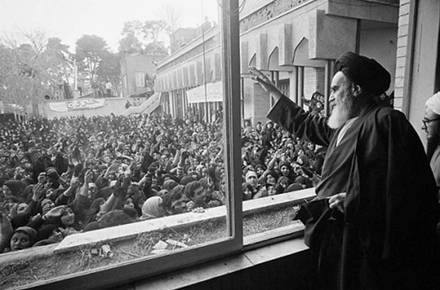 Two weeks later, 1 February, 80 thousands of people in the country came to the unprecedented mass service. Believers awaited the messenger of Allah.
Two weeks later, 1 February, 80 thousands of people in the country came to the unprecedented mass service. Believers awaited the messenger of Allah.And the Boeing 747 liner of Air France, flying from Paris to Tehran, has already appeared in the air. On board was the great ayatollah with his retinue of 50 assistants and confidants, accompanied by 150 journalists.
At the Mehrabad airport, the sea of people met the Ayatollah, chanting: “Allah is great! The shah is gone, the imam has come! ”From that moment, Khomeini became the main political figure of the country.
5 February 1979 Khomeini announced the illegality of the government of S. Bakhtiar and appointed Mehdi Bazargan as head of the provisional revolutionary government. It was a tactical move by the Ayatollah. 73-year-old Mehdi Bazargan received an engineering education in Paris. At one time he was an associate of Mosaddyk and one of the prominent figures of the National Front. The Shakha secret police threw him in jail four times. Bazargan enjoyed the support of both liberals and leftists.
At the same time, supporters of Khomeini and activists of the left-wing radicals - the “people's mujahidin” and the fedains — began to create armed groups.
Needless to say, the government of Bargazan Khomeini considered transitional on the way to the transfer of power to the radical clergy.
One of the important points in the disagreement of the government under the Revolutionary Council was the question of relations with the United States. President J. Carter and the US Department of State were extremely dissatisfied with the fall of the Shah's regime, but at first they acted extremely cautiously. So, they managed to negotiate with the new Iranian authorities about the evacuation of thousands of US citizens remaining in Iran 7, and most importantly, unimpeded removal of American electronic reconnaissance equipment installed during the Shah regime along the Soviet border.
However, the Americans refused to supply the new batches of weapons requested by the Iranian government, including destroyers (and, in fact, missile-carrying cruisers) ordered under the Shah, without inviting military advisers and experts from the United States.
On October 21, the US administration informed the Iranian government that the shah was granted a temporary visa for hospitalization in the United States, and the next day, the Rockefeller concern organized a shah flight to New York, where he was placed in a clinic. This gave Khomeini supporters a reason for decisive action. They decided to kill two birds with one stone - to put pressure on the United States and remove the government of Bazargan.
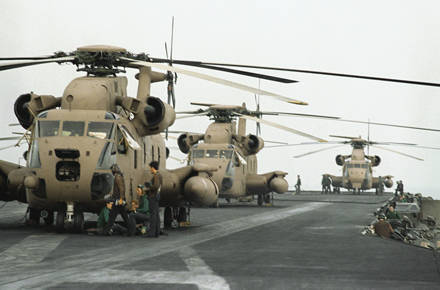 After the seizure of the embassy, the US State Department expressed “concern”, to which the Bazargan government responded that it “would make every effort to resolve the problem satisfactorily” and release the staff of the diplomatic mission.
After the seizure of the embassy, the US State Department expressed “concern”, to which the Bazargan government responded that it “would make every effort to resolve the problem satisfactorily” and release the staff of the diplomatic mission.However, Bazargan and his government were powerless to do anything to free the hostages, and Tehran Radio transmitted a message from the Prime Minister to Khomeini’s resignation on 6 in November. Ayatollah immediately satisfied the request of Bazargan, and transmitted by radio Khomeini’s decree on accepting the resignation and transferring all state affairs to the Islamic Revolutionary Council, which was charged with preparing a referendum on the “Islamic constitution”, presidential and Majlis elections, and conducting a “revolutionary, determined cleansing” in the state apparatus . The implementation of these activities constituted the main content of the “second revolution”, the victory of which, according to Khomeini, should have done much good for the “inhabitants of the huts, not the palaces”.
Thus, having organized the seizure of the embassy, supporters of Khomeini, using the anti-American sentiments of the entire population of Iran, created new state structures.
In December 1979, a nationwide referendum was held, endorsing the “Islamic Constitution.” In January 1980, the presidential elections were held, and in March - May of the same year, the parliament was elected. In August and September a new, permanent government was created.
In response to the seizure of the embassy, President Carter froze Iranian accounts in American banks, announced an embargo on Iranian oil (despite the energy crisis), announced the severance of diplomatic relations with Iran, the imposition of a full economic embargo against Iran. All Iranian diplomats were ordered to leave the United States within 24 hours.
Since both sides were clearly not going to make concessions, Carter tried to resolve the political crisis by other means. An American reconnaissance aircraft was sent to Iran, which unnoticed penetrated Iran’s airspace and even flew over Tehran.
As a result, US President Jimmy Carter agreed to conduct a military operation to free the hostages in Tehran. According to media reports, the operation was originally called the “Pot of Rice”, and later - the “Eagle Claw”.
According to the plan, the capture group on April 24 was supposed to secretly enter Iran on six military transport aircraft S-130 Hercules. Three of them were supposed to take on board the Delta fighters, and the other three - rubber tanks with aviation kerosene for refueling helicopters at a gas station with the code name "Desert-1", which was located about 200 miles (370 km) southeast of Tehran. On the same night, eight RH-53 D Sea Stallion helicopters were supposed to board the Nimitz aircraft carrier and, flying in a parallel course with four pairs, should land at the Desert-1 point half an hour after the planes.
After the landing of the Delta fighters and the refueling of the Hercules helicopters were to return to the departure airfield on Masira island off the coast of Oman, and the helicopters were to deliver the Delta fighters to the pre-planned shelter in the waiting area near Tehran, which was two hours before summer. and then fly to another point, 90 km from the shelter of the Delta fighters, and stay there under camouflage nets for the next day.
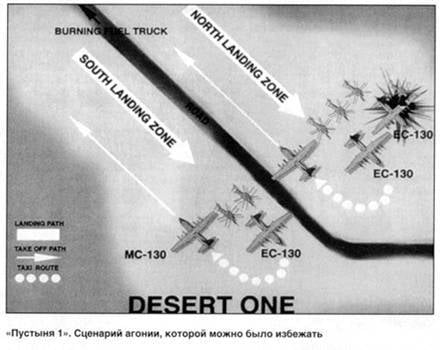 In the evening of April 25, the United States CIA agents, who had been abandoned in Iran, had to deliver 118 Delta fighters, accompanied by two former Iranian generals through Tehran streets, to the embassy of the United States. Closer to midnight, the group had to begin to storm the embassy building: through the outer walls, get to the windows, get inside, "neutralize" the guards and free the hostages. Then it was planned to call the helicopters on the radio to evacuate the participants in the operation and the former hostages either directly from the embassy or from the football field located in the neighborhood. Two AC-1 ZON fire support aircraft, patrolling over the embassy, would support them with fire in case the Iranians tried to prevent the helicopters from flying.
In the evening of April 25, the United States CIA agents, who had been abandoned in Iran, had to deliver 118 Delta fighters, accompanied by two former Iranian generals through Tehran streets, to the embassy of the United States. Closer to midnight, the group had to begin to storm the embassy building: through the outer walls, get to the windows, get inside, "neutralize" the guards and free the hostages. Then it was planned to call the helicopters on the radio to evacuate the participants in the operation and the former hostages either directly from the embassy or from the football field located in the neighborhood. Two AC-1 ZON fire support aircraft, patrolling over the embassy, would support them with fire in case the Iranians tried to prevent the helicopters from flying.In the early morning mist of early morning 26, April helicopters with rescuers and rescuers were supposed to fly 65 km in a southerly direction and land at the airfield of Manzaria, which by that time would be in the hands of the rangers company of the US Army. From there, the hostages were supposed to be delivered home on two C-141 jet transport aircraft, and the rangers were to return on C-130 aircraft.
Before proceeding with the operation, I would like to highlight three of its details. Well, first, what caused the selection of the “Desert-1” landing site? The fact is that in 1941 – 1945. there was a British military airfield, later abandoned. The place was chosen by the Yankees carefully, and the later arguments of their military that they, de, did not know that the highway passes close by, to put it mildly, were not serious.
A few days before the start of the operation, a twin-engine twin-engine turboprop passenger aircraft boarded the Desert-1 airfield. Its flight range was 1705 km, the capacity of 19 – 20 passengers. CIA agents led by Major John Kartney investigated the airfield for the possibility of landing the Hercules C-130 transport aircraft, and also installed light beacons. Lighthouses were supposed to be switched on by radio signals from approaching American aircraft. I note, the details of the flight "Twin Otter" are kept secret so far.
Not the most successful was the decision to use sea helicopters as rescue helicopters. The command of the temporary combined-arms tactical group chose the RH-53 D "C Steel" helicopters because of their heavy payload - more 2700 kg than the HN-53 helicopter. It was also taken into account that the release of the minesweeper helicopters from an aircraft carrier on the high seas would not attract attention to the upcoming special operation.
However, the crews of the RH-53 D sea helicopters were prepared to perform one combat mission: search and trawling of sea mines only during the daytime using a large trawl lowered on a towing cable.
The most curious moment - the fire support of the landing. The AC-130 N (“Ganship”) possessed a relatively high firepower: one 105-mm howitzer М102, one 40-mm automatic gun “Bofors” and two 20-mm six-barrel guns М61 “Vulcan”. I note that the last released about 5 thousands (!) Shots per minute.
The crew of the "Ganship" ("Kanonerki") - 13 people. All guns fired on one side. As you can see, the two AU-130 H could conduct effective fire on a crowd of Iranians, but the low-speed Gipship was easy prey for the oldest fighter.
As already mentioned, judging by some of the details leaked to the media, the Eagle Claw should be part of a much larger operation involving the US Air Force and Navy. In the media, there were photos of the Korsar-2 carrier-based attack aircraft of the Nimitz aircraft carrier with characteristic “quick identification” strips, which were plotted just before the start of Operation Eagle Claw. It is not difficult to guess that the "Corsairs" were supposed to cover the landing from the air. It goes without saying that deck fighters were supposed to cover helicopters and Hercules. Let's not forget that most of the personnel of the Iranian Air Force back in February, 1979 supported the Islamists.
During the operation "Eagle Claw" next to the aircraft carrier "Nimitz" at the entrance to the Persian Gulf was also the strike aircraft carrier "Coral Sea". Apparently, a joint attack of both aircraft carriers on Tehran or the bases of the Iranian Air Force was planned.
Before the start of Operation Eagle Claw, S-130 squadron was transferred to Egypt under the pretext of participating in joint exercises. Then they flew to Masirah (Oman). After refueling the squadron "Hercules" in the dark crossed the Gulf of Oman.
The first landing site was chosen unsuccessfully. After landing the head C-130, a bus passed along the sandy road. His driver and about 40 passengers were detained until the Americans left. Following the bus, a tanker truck loaded with fuel arrived, which American commandos destroyed from grenade launchers. A pillar of flame shot up from far away. In addition, two helicopters have already been lost, and one returned to the aircraft carrier. Commander of the operation, Colonel Bekkvit decided to stop the operation.
And then a catastrophe occurred. One of the helicopters, after refueling, did not calculate the maneuver and crashed into the Hercules fuel tanker. There was a powerful explosion, and both cars turned into torches. Burned all the fuel for the operation. Torn ammunition. The panic began. Not far away, the group of commandos thought it was an attack by the Iranians. They opened indiscriminate fire. The helicopter pilots, violating the charter, abandoned their cars and ran to a safe place. Secret cards, ciphers, tables, state-of-the-art equipment, thousands of dollars and reals remained in the cabs. Colonels Beckwith and Kyle could do nothing. There was only one thing left - to get out of here quickly. Such an order followed. Colonel Beckquit ordered to drop everything, boot into the Hercules and retreat. The chiefs also violated the charter, not eliminating the remaining helicopters. Later, these “C. Steel” served in the Iranian army for several years.
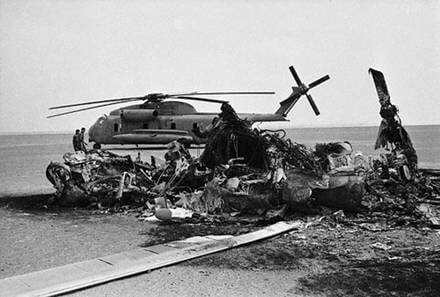 When the Yankees took to the air, five RH-53 D helicopters remained on the ground. Operation Eagle Claw cost 150 million dollars and eight fallen pilots.
When the Yankees took to the air, five RH-53 D helicopters remained on the ground. Operation Eagle Claw cost 150 million dollars and eight fallen pilots.Later, when the invasion of Iranian territory became public, the Sultan of Oman protested and terminated the agreement with the United States, which allowed the Air Force and Navy to use Masirah for their needs.
6 May 1980. President Carter ordered mourning for eight "dead guys" in the country.
In my opinion, the operation "Eagle claw" was doomed to failure under the most favorable set of circumstances. Even if the Delta detachment managed to break through to the embassy, well-armed students and army units located nearby would have fierce resistance.
As American journalist Michael Haas wrote: “Overcome by religious zeal, an Iranian, in a normal state, a polite man turns into a distracted fanatic, who has almost no fear of death. How else to explain the readiness of Iranian adolescents, driven by the mullahs to frenzy, to act in the Iran-Iraq war in the role of live mine detectors, groping for mines with their bare feet? To a person of Western culture, this seems alien, but, nevertheless, is one of the main components of Iranian culture. ”
The bombing of Tehran by American carrier aircraft would inevitably lead to large civilian casualties. Nevertheless, neither the paratroopers nor the hostages could have escaped, but Tehran would have to go to an alliance with Moscow.
After the failure of the Eagle Claw operation, US Secretary of State Cyrus Vance resigned. The Carter administration immediately began preparing a new military operation to free the hostages, called the Badger.
By August 1980, the Barsuk group was ready to speak immediately after receiving full information from the CIA on the whereabouts of the hostages. However, neither the command of the operation, nor the White House were satisfied with the incoming information because of their incompleteness, and the consequences of the liberation of only a few Americans were too obvious for everyone. Not wanting to be unclear, the head of the operation, Major General Sekord, unambiguously explained to the Chiefs of Staff Committee that Badger was a hammer, not a needle; the casualties among the Iranian population will be huge.
Operation Badger assumed no less than the seizure of Tehran International Airport by forces of at least two ranger battalions, the rescue of the Delta group from the intended holding sites in Tehran and the evacuation of the troops involved and the hostages by transport aircraft under the cover of deck attack aircraft, which from the beginning and before the end of the operation had to circle the city. F-14 carrier-based fighters were to be on duty above them to intercept any Iranian aircraft.
As historian Philip D. Chinneri wrote in his book “Anytime, Anywhere,” more than a hundred aircraft and 4000 troops were to strike with a hammer in the heart of one of the largest cities in the world. For comparison: a total of 54 aircraft and helicopters participated in Operation Eagle Claw, a 118-person Delta group and a ranger company deployed at an aerodrome intended for evacuation.
There were no further attempts to rescue the hostages.
The State Department had to move from carrot to carrot - negotiations began with the Iranian authorities. By the end of January 1981, the Iranian delegation led by Bakhzad Nabawi in Algeria reached an agreement with the United States regarding the release of American hostages by 52. Washington defrosted Iranian assets worth 12 billion. A huge part of this money (4 billion dollars) went to payments on the claims of 330 of US companies and individuals. Iran agreed to return its debts to various foreign banks (3,7 billion dollars). So the Iranian government received "clean" only 2,3 billion dollars. 52 American hostage, having survived the 444 day of captivity, 20 January 1981 were released and on the Boeing-727 flew from Mehabad to the US military base in West Germany Wiesbaden.
The resolution of the crisis with the American hostages once again proves to us that the political rhetoric of the governments of Iran and the United States and their practical actions often lie in opposite areas. Since the beginning of the “Islamic revolution” in Iran and to this day, all political and clergymen have been cursing Israel with great zeal and even urge to take it off the face of the earth. And on the sly at the beginning of 1980, Israel and the “revolutionary” Iran concluded an agreement on the supply of spare parts for American weapons and new military equipment in exchange for the provision of exit visas to Iranian Jews leaving for Israel.
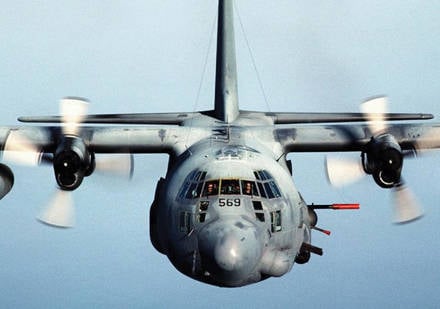 Further more. In 1985 – 1986 The US concludes a secret agreement with Iran’s “nest of terrorism” on the sale of large batches of ultra-modern weapons - the newest versions of Hawk anti-aircraft missiles, TOW anti-tank missiles, etc. The Americans received funds from these deals for the military assistance of the Contras, who fought in Nicaragua against the legally elected Sandinistas government. The most curious thing is that the transit point for aircraft carrying weapon to Iran, was ... Israel. It is clear that Israeli diplomats and intelligence officers played the most active role in the Iran-Contra scam.
Further more. In 1985 – 1986 The US concludes a secret agreement with Iran’s “nest of terrorism” on the sale of large batches of ultra-modern weapons - the newest versions of Hawk anti-aircraft missiles, TOW anti-tank missiles, etc. The Americans received funds from these deals for the military assistance of the Contras, who fought in Nicaragua against the legally elected Sandinistas government. The most curious thing is that the transit point for aircraft carrying weapon to Iran, was ... Israel. It is clear that Israeli diplomats and intelligence officers played the most active role in the Iran-Contra scam.US officials and the military did not like to recall the operation "Eagle Claw". But in 2012, the Americans were able to take revenge. The operation, shamefully lost by the Air Force, the Navy and the Delta Group, brilliantly won ... Hollywood in the movie “Operation Argo”. The fact is that on the day of the storming of the American embassy by Iranian students, six American diplomats took refuge in the Canadian embassy. To help them leave Iran, a CIA agent arrives in the country. Under the guise of the crew of the fantastic film “Argo”, the fugitives successfully pass the test cordons at Tehran airport and leave the country.
Iran decided to sue Hollywood for the film “Operation Argo” after officials in culture and film critics watched the picture in a closed show in Tehran. They concluded that the film is a “CIA product”, contains anti-Iranian propaganda and distorts historical facts. Masoumeh Ebtekar, a member of the Tehran city council and a participant in the seizure of the American embassy in 1979, claims that the film’s director Ben Affleck showed the ire of Iranians, bloodlust and ignored the fact that most of the seizure participants were peaceful students.
And at the beginning of 2013, Tehran decided to strike back and began shooting a feature film called “General Staff” with its version of 1979 – 1980 events.
In conclusion, I would like to note that I did not find a single trace of the “hand of Moscow” in any of the dozens of foreign and domestic materials relating to this operation. Nevertheless, our sailors were well aware of almost all movements of American ships, and especially aircraft carriers in the Indian Ocean. Then we were a great power. From 1971 to 1992, the 8-i operational squadron existed for the year, the operational zone that was the Indian Ocean and especially the Persian Gulf.
In the 1979 – 1980 in the Indian Ocean, our atomic missile submarines of the 675 project with the P-6 missiles and the 670 and 671 projects with the Amethyst missiles were constantly located. They tried to keep American strike aircraft carriers continuously in the missile zone.
From the airfields in Aden and Ethiopia, our anti-submarine IL-38 aircraft and the Tu-95 RC cruise missiles were conducting reconnaissance. I note that in the year 1980 only IL-38 averaged about 20 sorties over the Indian Ocean and the Persian Gulf. By the way, after the shah was overthrown, the Iranian authorities allowed a flight from the Central Asian airfields to the Indian Ocean of our IL-38 and Tu-95 RC.
Finally, we should not forget about our reconnaissance satellites and US-A and US-P spacecraft of maritime intelligence and cruise missile guidance. Our sailors and pilots tracked each strike of strike aircraft carriers to the borders of Russia to the range of deck aircraft. And, of course, were aware of all American ploys.
Information